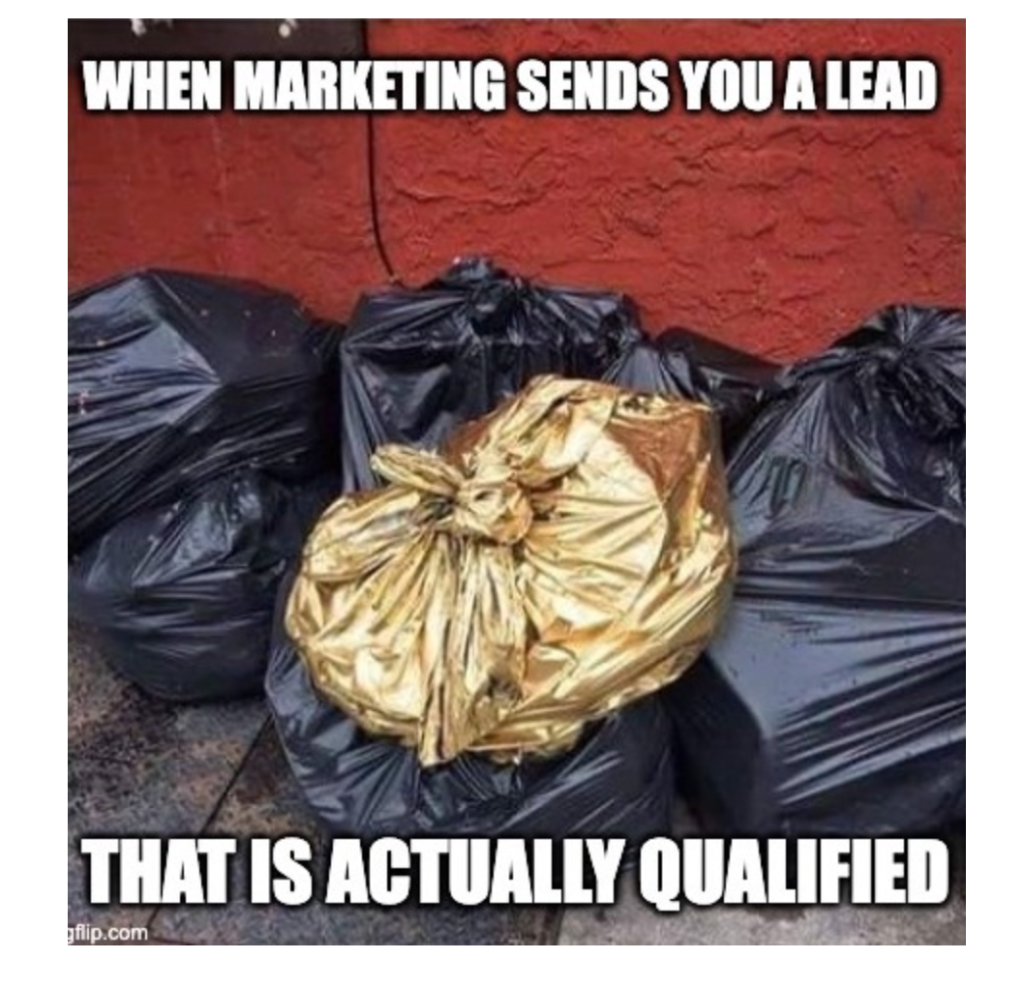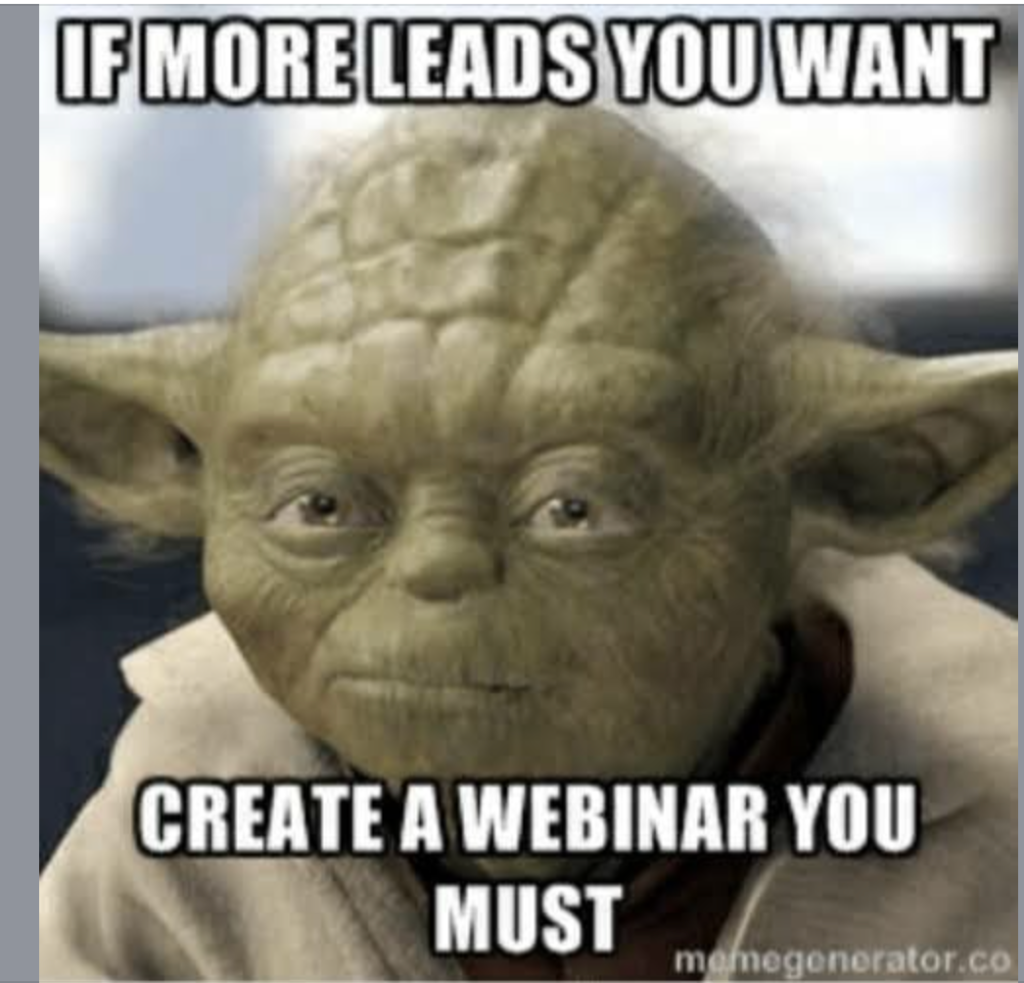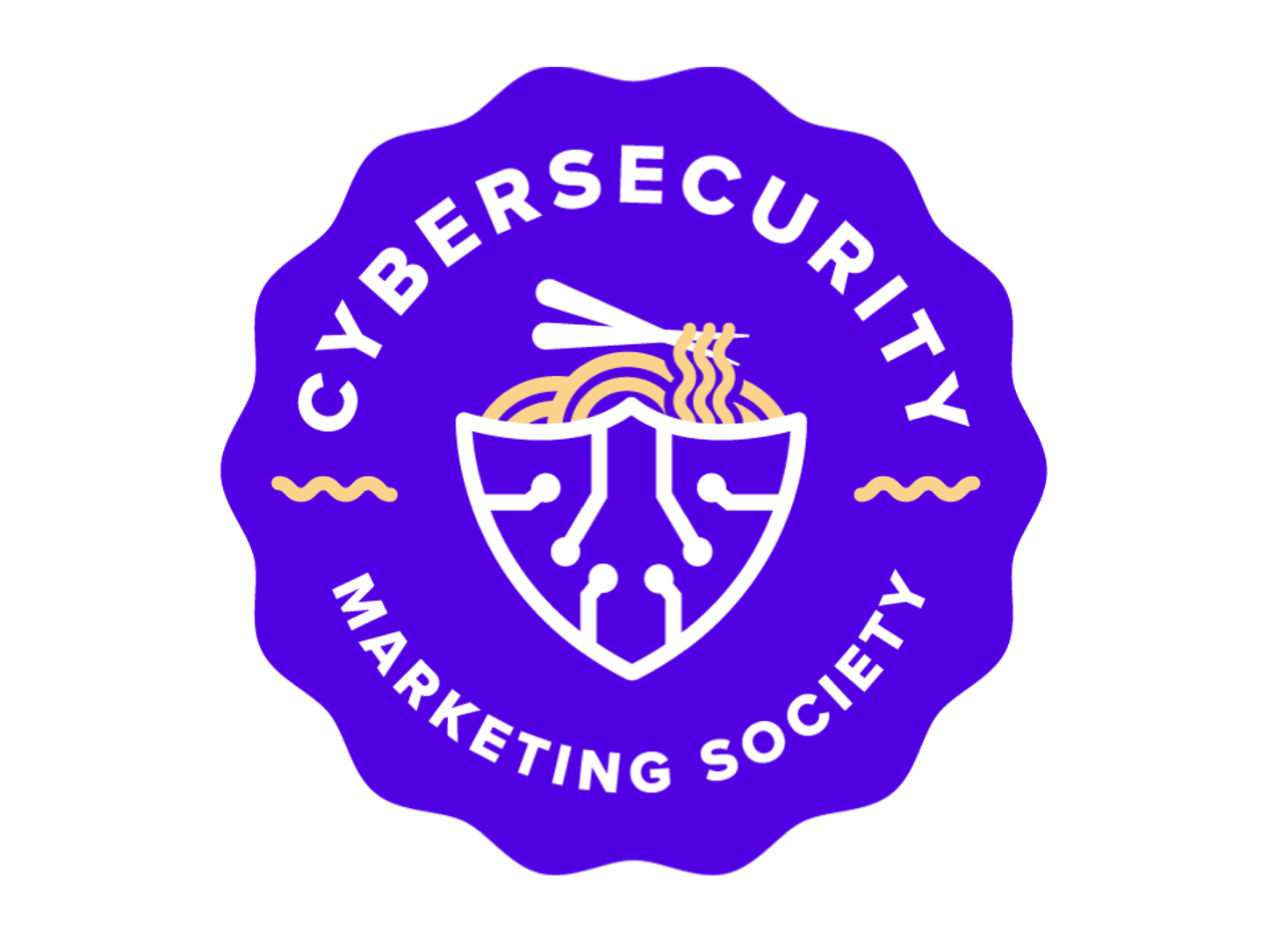How to optimize your Lead to MQL to SQL Conversion Rate
Author: Alicia Beaubien
As you may know, the Cybersecurity Marketing Society is here to help and offer advice around marketing strategies to make the most of your marketing efforts—no matter the size of your team.
Anyone can bring in leads, but not everyone can bring quality leads. Your CEO or leadership team may think you can easily buy leads, but that’s old-school thinking that can ultimately lead to your organization getting blacklisted. 😬
But don’t worry. We have 3 strategies to help you convert leads into marketing qualified leads and, ultimately, ROI.
 Meme credit to Wishpond’s 30 Marketing Memes Only Business Owners and Marketers Will Understand.
Meme credit to Wishpond’s 30 Marketing Memes Only Business Owners and Marketers Will Understand.
Improving Lead to MQL to SQL Conversion Rate
Shockingly or not, according to UnboundB2B, 39% of B2B SaaS leads convert to marketing qualified leads (MQLs). But this is one of the higher conversion rates among the different industries.
It’s critical to target your marketing efforts and have a consistent qualification process to have a good conversion rate from lead to MQL.
Understanding the Qualification Journey
Definitions and significance
On ActualTech’s blog, How To Improve Your Lead-to-MQL-Conversion Rate, they go into great detail around the definitions of each stage in the buyer journey as well as an ideal path to return on investment (ROI).
Here’s a quick overview to get you started:
- Lead is a potential prospect that you’ve captured data from through a badge scan, form fill, email subscription, etc.
- Marketing Qualified Lead is often referred to as an MQL, meaning it’s one step above a Lead as it ideally matches your marketing team’s definition of a targeted customer profile.
- Sales Qualified Lead known as an SQL is an MQL with a high buyer’s intent, typically including proper budget, authority purchase or influence, need for your product/service, and appropriate timing to purchase.
- Opportunity is an SQL with interest in a specific deal with a high probability of closing, which includes upselling, cross-selling, or the potential of purchasing a new product or service.
- Closed is typically the last step in the buyer’s journey, where hopefully the lead makes a purchase. But you can also see a “Closed Lost” status if an Opportunity opens but no purchase was made.
Often in our industry, there is confusion on SQL vs. MQL. It’s important to align with sales and leadership to ensure you agree with the definitions for your specific product and niche.
Note: Not every lead should be considered an MQL. Otherwise, it’s a great way to annoy and overwork your sales team with unqualified leads.
 Meme credit to Reply’s 20 Relatable Sales Memes You’ll Want to Share With the Team
Meme credit to Reply’s 20 Relatable Sales Memes You’ll Want to Share With the Team
What is a good lead conversion rate?
First, to measure your success in converting leads into MQLs, SQLs, and, ideally, Opportunities, you need to understand how to calculate lead conversion rate and benchmark your campaign success.
Lead Conversion Rate Formula = Total # of MQLs / Total # of Leads x 100 = %
As mentioned earlier, the average B2B lead conversion rate in cybersecurity is 39%. This is a good benchmark to keep in mind when generating leads. Of course, every company is unique depending on your ideal persona, company size, etc.
You can determine your lead conversion down the pipeline path by leveraging the same formula and dividing it by the stage before. So example: SQLs/MQLs x 100 = %. Continue through the funnel to reveal your conversion rates as seen here in ActualTech’s blog.

Source: How To Improve Your Lead-to-MQL-Conversion Rate
Formulating Quality Leads
To determine your MQLs, you need to establish qualification material around your ideal customer persona (also known as ICP). Despite all of us being in cybersecurity, each persona and qualification rules should be specific to your organization and product or service.
Example of target persona for cybersecurity companies:
- Titles: CISO, CIO, VP of Security, Threat Research, or System Administrator
- Industries: FinTech, Healthcare, Education, or Government
- Age Range: 30s-50s
- Pain points: Lack of security visibility, too many tools, compliance requirements
Be sure to research your particular product, review your Customer Relationship Management (CRM) data, and survey your current customers to learn more about your ICP.
While working through your ICP, consider your prospects’ buying practices and map your buyer’s journey.
Example of a buyer’s journey for cybersecurity and tech companies:

Source: The Enterprise Tech Buyer’s Journey: A Step-by-Step Guide To Optimize Your Process
Ideally, your prospects will go through an Awareness, Consideration, and Decision stage, and then hopefully repeat this process as a return buyer. To learn more budget-saving tips and gain further insights, check out ActualTech’s blog, How To Improve Your Lead-to-MQL-Conversion Rate.
Incorporate Lead Scoring for Quality
Another great way to manage and sort your leads is through lead scoring. Lead scoring is exactly how it sounds, you associate a score to your lead’s attributes like demographics and actions that they take.
Example of lead scoring models
- Hubspot’s Lead Scoring 101: How to Use Data to Calculate a Basic Lead Score
- Lead Scoring with Salesforce
- Chili Piper’s What is Lead Scoring and How to Score Leads in 4 Easy Steps
PRO TIP: Ensure you filter out low-quality leads before they come into your CRM or marketing automation solution. You can do this by setting parameters directly on your form by including company size or job title. However, be mindful of how many fields are on your forms, as you may lose more conversions.
You can also filter leads out on your backend automatically through workflows or manually such as personal email, or qualify/disqualify leads through solutions like Lean Data or Chili Piper.
Have additional lead conversion questions?
We’ve got you! Join the Cybersecurity Marketing Society. We have over 2500 members who are always willing to help you brainstorm and offer new ideas through our community Slack Channel.
If you are in marketing operations (MOPs) or looking to learn more about lead scoring and buyer personas, join our MOPs Monthly. There, you can ask questions and learn industry best practices.
Using 3 Targeted Marketing Strategies that Work
There are many steps to setting up lead qualification and routing as you read above. But once you have that all set up, you can reduce your spending and see an ROI of tenfold.
Last but not least, we want to talk about three proven strategies that we’ve, as a cybersecurity marketing community, have seen pay off in dividends.
- Content Syndication for Lead Generation
Content—it’s so hot right now! 🔥You literally can’t create enough. You could blog three times a day and still need to produce more content to fill in gaps in your buyer’s journey or talk about the latest vulnerabilities. In cyber, it doesn’t stop, and our target market wants to stay informed.
 Meme credit: PepperContent’s 10 Marketing Memes and GIFs Any Inbound Marketer Will Love
Meme credit: PepperContent’s 10 Marketing Memes and GIFs Any Inbound Marketer Will Love
So how do you make the most of your content? Geordie Carswell, CMO of ActualTech, spills all the tea in this video, Making Lead Gen Work.
One of the best ways to make the most out of your content is to repurpose and reuse it. And you can do that through content syndication, which republishes your existing content through other mediums.
The majority of your content can be leveraged across content syndication services including but not limited to blogs, e-books, webinars, on-demand videos, infographics, and podcasts.
PRO TIP: If you’re looking to jump on the podcast bandwagon and stand out in cybersecurity podcasting, check out this episode with podcast experts and hosts of the Top 50 Cybersecurity podcast Hacker Valley Studio, Chris Cochran and Ron Eddings.
Considering content syndication?
Key benefits include:
- Creating a targeted audience with your ICP
- Maximizing return (ROI) on your content time and investment
- Increasing sales conversions
- Obtaining cost-effective costs per lead
- Gaining measurable lead generation results
PRO TIP #2: If you leverage content syndication platforms, like ActualTech Media, ensure you and/or the provider leverage campaign and URL tracking. Then you can accurately measure your results to determine your ROI.
For additional information on content syndication, check out these 15 Ways To Boost Your Content Syndication ROI.
2. Webinar Marketing for Lead Generation
“Over the past few years, webinars have fast become one of the top lead-gen tactics in the B2B world. In fact, more than half of B2B marketers (53%) say they’re the No. 1 way to generate high-quality top-of-the-funnel leads. In other words: Your B2B brand needs a webinar strategy, and stat,” according to ActualTech.
 Meme credit to Webinar Memes
Meme credit to Webinar Memes
During COVID (circa 2019-2022), webinar fatigue was real! But now, webinars are back and stronger than ever. With that in mind, almost every single cybersecurity company is hosting them. So how do you stand out?
For one, you can use that to your advantage. You can partner with other cybersecurity organizations that touch on similar topics to you without being direct competitors. One webinar example is how Blumira partnered with eight other cybersecurity vendors who offered free solutions for small businesses. You can view their webinar here.
Blumira made these connections through the Cybersecurity Marketing Society. By banding together, they were able to deliver 8x of the leads they would have on their own.
For other webinar best practices, check out these great resources, How to Create Tech Webinar Content Strategy and How to Build a Webinar Lead Generation Engine: A New Strategy for Cybersecurity Vendors.
Need help executing all the moving parts or not sure where to start? Consider a webinar marketing agency like Actual Tech.
3. Event and Tradeshow Strategy for Lead Generation
Tradeshows are coming and they are right around the corner! With one of the biggest conferences just weeks away (RSA Conference – May 6-9, 2024).
 Meme credit to imgflip
Meme credit to imgflip
Conference and tradeshow marketing is huge for the cybersecurity industry. Especially RSA Conference and Black Hat, which are seen as be-there or be-square type of events. If you’re looking for tips to make the most of these types of events, check out this article, Advice for your First (or Third, or Tenth) RSA Conference—and, of course, it can apply to other shows too.
These two aren’t the only events. There are thousands! And the more you Google, the more you’ll find. But you’ll need to determine where your ICP attends or goes to learn more.
Keeping that in mind, we think you’ll learn a ton from our recent podcast with Anthony Johnson, CEO at Delve Risk, on the Highest Concentration of CISOs? Determining Buyer Location When Planning Events.
Whatever events and conferences you determine are right for you, you can potentially see some strong tradeshow leads as this is the perfect place to show your ICP a demo, get real-time feedback, and answer questions live.
But ensure that you have a strong conference strategy going into any event with bold messaging, a brand presence that stands out, and good booth staffing that is prepped for technical talks with your specific buyer personas.
If you want to learn more about events or are a field marketer, check out the Cybersecurity Marketing Society’s Field Marketing Monthly.
Use an Omnichannel Approach for Lead Generation
No matter how you choose to generate leads, be sure to diversify, just like stock. Although we’re all in cybersecurity, we know from experience that what works for one cybersecurity organization won’t always work for another one.
By using an omnichannel marketing approach, you can help move leads through the lead funnel even quicker with multiple touches. This could include events, webinars, content syndication, social media, email, ABM, and so on. You will see even more success when you combine and track these efforts.
If you’re interested in learning more about omnichannel marketing, check out Hubspot’s What is Omni-Channel? 20 Top Omni-Channel Experience Examples.
We’ve provided a ton of information for you today and it will take some time to implement it all, but it’s well worth it once you’ve established your key personas, buyer’s journey, and marketing sources that work best for you.
If you’re looking for more information about Lead to MQL conversion rates, head on over to ActualTech Media’s blog. Or if you have specific lead generation questions, feel free to set up some with Cybersecurity Marketing Society’s CMO in Office Hours with Gianna Whitver for Cybersecurity Marketing Society Members.
Looking for some casual meetups, chats, and networking opportunities? Sign up for our Morning Coffee and join the Cybersecurity Marketing Society to make friends, learn and share best practices, and grow your skills.
Join the Society.

Recent Comments